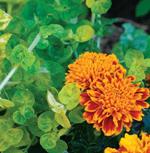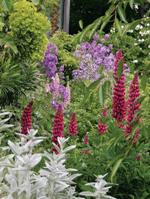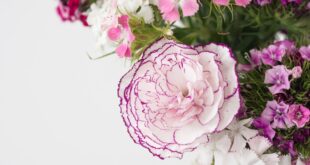
I HAVE a friend living about two doors away, who grew white petunias for our daughter’s wedding last year (she and daughter have a mutual love of white flowers and are in total agreement about the need for minimalism in all things). My friend is crushingly honest, loves rhododendrons, roses and lilies but is not really a plantsperson. Trouble is, she keeps trying to re-design my garden. And, damn it, she’s right half the time. Like last week. She came in to see what was blooming.
In all modesty I have to say there was a lot in flower. Where burnt, brown summer grass used to come right to the edge of the house, there is now a wide border composed originally from layers of newspaper, compost and manure. It’s warm, wormridden, well-mulched and fertile. Roses in shades of apricot, cream, yellow and white are in full flight. (This friend grows only white roses.) Brilliant blue salvias set off the apricot and yellow to perfection (I think). There are some other colours but I won’t talk about them, except to say that there are also some shapely evergreen bushes for winter interest. Two of them are glossy-leafed griselinias that existed when we bought the house and were once totally out of control. Now they’re carefully clipped into chunky square columns. “Now,” says my friend with a critical glance, “just imagine if you trained the griselinia as a hedge right along the house under the window. You could take out most of the other stuff – except the white roses of course – and it would look great.”
 My friend is right – again. But trying to reconcile design with desire is a perennial problem when you happen to be a plantaholic, love putting different combinations together and have only a small space to work in. So my garden under the window is remaining as is – at least until the autumn. Another gardening friend dropped by this morning with a photograph of a rare meconopsis she would like printed. “Is Russell around?” she asked. “I have this gorgeous combination I thought you might like to photograph.” Now this lady is much more my style. Her garden is full of beautiful and unusual plants, often growing together in wonderful colour combinations, some planned, some serendipity. In any garden, it’s always the combinations that catch my eye – and make good photographs. Last November, members of our garden club went visiting. First stop was Ophir, probably the coldest town in New Zealand in winter. Unfortunately, late frosts had delayed the flowering of roses but bearded irises were in full flower. I’m on record as saying I detest these stately proud plants, but that was in another age. Now I love them for their elegant form that makes them stand out among groupie things. Both their shape and the stunning range of colours that exist, make them an excellent flower to play with in combinations. Sue Guthrie, who gardens beside an old stone cottage in Ophir, has deep blue, tall-bearded irises clustered with blue pansies, apricot irises beside the mauve flowers of chives and pale blue irises threaded with orange poppies. Gorgeous!
My friend is right – again. But trying to reconcile design with desire is a perennial problem when you happen to be a plantaholic, love putting different combinations together and have only a small space to work in. So my garden under the window is remaining as is – at least until the autumn. Another gardening friend dropped by this morning with a photograph of a rare meconopsis she would like printed. “Is Russell around?” she asked. “I have this gorgeous combination I thought you might like to photograph.” Now this lady is much more my style. Her garden is full of beautiful and unusual plants, often growing together in wonderful colour combinations, some planned, some serendipity. In any garden, it’s always the combinations that catch my eye – and make good photographs. Last November, members of our garden club went visiting. First stop was Ophir, probably the coldest town in New Zealand in winter. Unfortunately, late frosts had delayed the flowering of roses but bearded irises were in full flower. I’m on record as saying I detest these stately proud plants, but that was in another age. Now I love them for their elegant form that makes them stand out among groupie things. Both their shape and the stunning range of colours that exist, make them an excellent flower to play with in combinations. Sue Guthrie, who gardens beside an old stone cottage in Ophir, has deep blue, tall-bearded irises clustered with blue pansies, apricot irises beside the mauve flowers of chives and pale blue irises threaded with orange poppies. Gorgeous!
As with any plant, bearded irises look most spectacular when allowed to clump up and form colonies. In another garden we visited recently, we saw a large clump of lemon irises on a bank and rising up behind them was an equally large clump of mustard-coloured irises. Great! In November and December, Russell lupins flower in the south, not only growing wild alongside the highway but also appearing as garden plants, invited or not. Welcome for their varied colours as well as their height, they form great combinations with roses for example and, by their very contrast, can be used to emphasise the big voluptuous blooms of peonies.
Foxgloves serve a similar purpose. In an immaculate Dunedin garden in early December I once saw slender white foxgloves highlighting a massed planting of Rosa ‘Mutabilis’, a beautiful old rose with flowers that change, as they age, like the colours of a sunset – even more impressive to my eyes because ‘Mutabilis’ has proved a dismal failure in two of our gardens. Nearby dark blue lupins and white foxgloves, rising above green shrub foliage, provide an unusual counterpoint to a neighbouring cordyline. A caution though: there are a couple of problems with lupins. One is their perfume which can cause allergic reactions such as hay fever; the other is their propensity, particularly it seems in southern gardens, to spread far and wide. Once the lowers are over, I take care to remove the seed pods from the plant that arrived unannounced in our garden,
 When composing garden ‘pictures’, blue and lime green are indispensable. Together they make a vibrant duo but they have the virtue also of complementing no-matter-which other colours. Many euphorbias provide brilliant, long-lasting lime flower heads – those of E. characias and its hybrids form big, globular shapes on long strong stems; E. amygdaloides varieties – which are prone to mildew in our garden – produce smaller heads of flowers and those of E. cyparissias are even smaller. Beware though, the latter can become invasive.
When composing garden ‘pictures’, blue and lime green are indispensable. Together they make a vibrant duo but they have the virtue also of complementing no-matter-which other colours. Many euphorbias provide brilliant, long-lasting lime flower heads – those of E. characias and its hybrids form big, globular shapes on long strong stems; E. amygdaloides varieties – which are prone to mildew in our garden – produce smaller heads of flowers and those of E. cyparissias are even smaller. Beware though, the latter can become invasive.
If you prefer something daintier, Lady’s mantle (Alchemilla mollis) with its frothy lime green flowers in early summer is a delight – and may spread its delight willy-nilly throughout your garden. Golden oregano forms a low-growing clump and is not only a bright yellow/lime colour but is also a useful culinary plant. Berberis thunbergii ‘Aurea’ is a tough customer, equally useful for deterring unwanted foot traffic with its spiny branches or for providing illuminating colour in shade. Combine these plants with red and orange for jump-out vibrancy, or fuse them with soft purples and pinks for a gentler look. And if, like my friend, you must have simplicity and white roses, then what better colour to go with them than lime green.










Join the Discussion
Type out your comment here:
You must be logged in to post a comment.